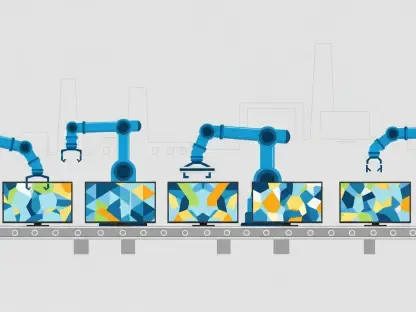The digital landscape has undergone a profound evolution, making the need for a robust security framework more crucial than ever. Secure Access Service Edge (SASE), a term coined by Gartner, has emerged as a significant innovation in the field. By integrating both network and security functionalities into a single cloud-native platform, SASE addresses modern enterprise security challenges with impressive agility. This platform combines elements like SD-WAN, Security Services Edge (SSE), and cloud networks to ensure seamless, secure connectivity, irrespective of user location. As businesses increasingly rely on remote work and cloud-based solutions, SASE is setting the foundation for a secure digital transformation.
Addressing Complex Security Needs
The Power of Consolidated Security Functions
In recent years, the rapid surge of connected devices across networks and the expanding remote workforce has posed significant security challenges for enterprises. To address these, SASE provides a sophisticated yet comprehensive set of security features. These include Firewall as a Service (FWaaS), Cloud Access Security Broker (CASB), Data Loss Prevention (DLP), Secure Web Gateway (SWG), and Zero Trust Network Access (ZTNA). By consolidating these diverse functions, SASE delivers a unified security strategy that simplifies management and enhances protection against threats.
The consolidation of security functions allows businesses to deploy consistent policy enforcement, which is crucial for ensuring protection across all user locations. This approach minimizes vulnerabilities often found in traditional security models due to fragmentation and inconsistency. Moreover, with SASE’s robust threat protection capabilities, companies are better equipped to manage and mitigate risks associated with cyber threats. The emphasis on a holistic security model means enterprises can focus on strategic initiatives, confident in the knowledge that foundational protections are in place.
Unified Policies for Enhanced Security
Implementing SASE allows organizations to standardize security policies, which is a significant advantage when managing a multifaceted IT environment. With a single set of policies applied universally, enterprises can ensure that security measures are both consistent and scalable, regardless of the number of locations or endpoints. This uniformity also supports the integration of Zero Trust principles, further tightening security by verifying every user and device before granting network access.
The benefits extend beyond mere security; unified policies reduce the complexity inherent in managing numerous standalone solutions. By centralizing control over security settings, enterprises can respond more agilely to emerging threats. This streamlining of processes ultimately results in cost savings, as it requires fewer resources to manage the security infrastructure. The reduction in administrative overhead frees up IT teams to focus on more strategic tasks that drive business value, rather than being bogged down by routine security issues.
The Practical Benefits of SASE Adoption
Agility and Cost Efficiency
One of the most compelling reasons for companies to transition to SASE is its inherent agility and cost efficiency. Traditional network security models often involve complex setups and significant expenditures on hardware and maintenance. In contrast, SASE offers a more streamlined, cloud-based solution that significantly reduces these costs. By eliminating reliance on physical infrastructure, enterprises can scale their security capabilities as needed, adapting quickly to changing business requirements.
This flexibility is particularly vital for organizations looking to expand or alter their operational strategies rapidly. With SASE, new locations can be integrated into the existing network setup easily, without the need for extensive physical installations. Additionally, supporting mobile or remote users becomes seamless, ensuring they access corporate resources securely and efficiently. This capability is indispensable in today’s highly dynamic business environment, where agility can be a critical competitive advantage.
Bolstering Remote Work
In an era where remote work is not just commonplace but expected, SASE’s capabilities cater exceptionally well to this shift. The integration of comprehensive security and networking functions into a single cloud service means employees can access necessary resources wherever they are, without compromising security. The ability to maintain optimal application performance, regardless of location, ensures that remote work does not impede productivity.
Remote access, underpinned by SASE’s Zero Trust model, ensures that each access request is scrutinized, providing robust protection against unauthorized intrusions. This model is particularly effective in environments where BYOD (Bring Your Own Device) policies are prevalent, as it minimizes risks posed by unsecured devices. By facilitating secure remote connections, SASE supports a flexible, productive workforce, aligning with modern business needs and expectations.
Envisioning the Future of Enterprise Security
Shaping Enterprise Network Architecture
The advent of SASE marks a pivotal shift in enterprise network architecture, emphasizing a future where security and network functions are indistinguishably integrated. This model streamlines operations, providing enhanced user experience and reliability across various digital platforms. Businesses adopting SASE benefit from seamless connections, whether their operations are cloud-centric, remote-based, or traditional.
Moving away from old security paradigms, SASE introduces efficiency and logic into digital frameworks that were previously mired in complexity. This transformative approach is not only modernizing security measures but is also laying the groundwork for further advancements in network technologies. As enterprises continue to seek out solutions that are both secure and adaptable, SASE’s architecture is anticipated to become increasingly standard, especially as digital landscapes evolve.
Preparing for a SASE-Dominated Future
The digital landscape has seen a remarkable transformation, with the demand for a strong security framework becoming more pressing than ever. Secure Access Service Edge (SASE), a strategic concept introduced by Gartner, is revolutionizing the security sector. SASE integrates network and security capabilities into a unified, cloud-native platform, offering a comprehensive response to modern enterprise security demands with remarkable flexibility and speed. By merging elements such as SD-WAN, Security Services Edge (SSE), and cloud networks, SASE promises uninterrupted and secure connectivity, no matter where users are located. As organizations grow more dependent on remote workspaces and cloud-based infrastructures, SASE is establishing the groundwork for a safe digital evolution. This approach not only facilitates the shift to cloud and remote operations but also ensures that companies maintain robust security postures, adapting to the ever-changing digital environment effectively.









